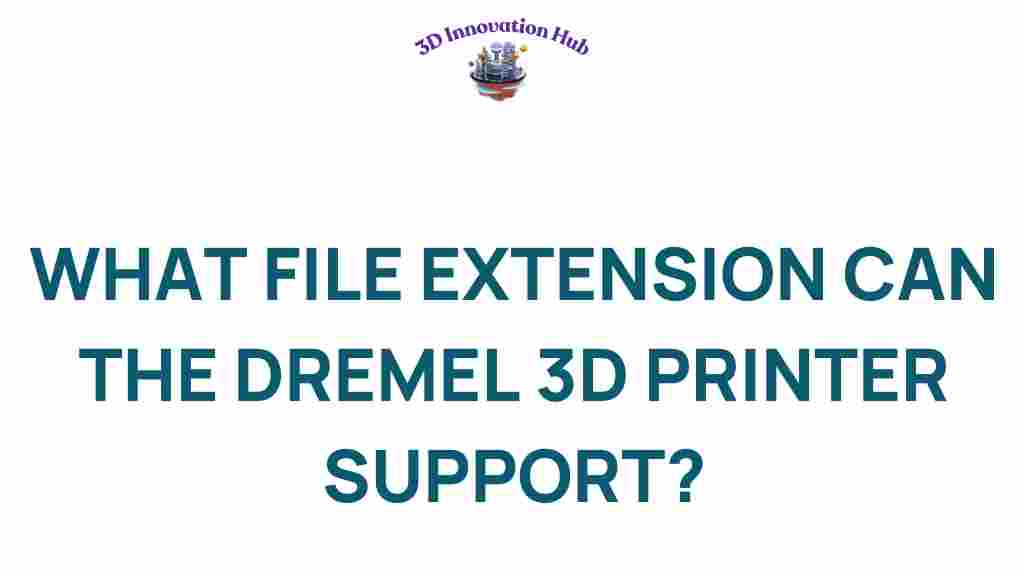Unlocking Creativity: Dremel 3D Printer File Extensions and Their Importance
The Dremel 3D printer has revolutionized the way hobbyists and professionals approach design and production. With its user-friendly interface and advanced printing technology, it opens doors to endless possibilities in the world of additive manufacturing. However, to fully unlock your creativity, it’s essential to understand the various file extensions that the Dremel 3D printer supports. In this article, we will delve into the different design files you can use, focusing on the most common formats like STL and OBJ, and provide you with a comprehensive guide to enhance your 3D printing experience.
Understanding File Extensions in 3D Printing
In the realm of 3D printing, file extensions are crucial as they determine how a 3D model is interpreted by the printer. Each format carries specific information about the model, such as geometry, texture, and color. Understanding these formats is vital for anyone looking to create or print 3D models effectively.
Common File Extensions Supported by the Dremel 3D Printer
The Dremel 3D printer supports a variety of file extensions, each serving a different purpose in the printing process. Here are the most commonly used formats:
- STL (.stl): The most widely used format in 3D printing, STL files contain the surface geometry of a 3D object. They are essential for creating accurate models and are supported by most CAD software.
- OBJ (.obj): This format supports both geometry and texture information, making it suitable for more complex models that require color and surface details.
- 3MF (.3mf): A newer format designed specifically for 3D printing, 3MF files can contain rich information about the 3D model, including colors and materials.
- G-code (.gcode): This format is a set of instructions that the printer understands, outlining how the printer should move and extrude filament to create the model.
How to Prepare Your 3D Models for Printing with Dremel
To ensure a smooth printing process with your Dremel 3D printer, follow these steps to prepare your design files:
Step 1: Create or Download a 3D Model
You can either create your own 3D models using CAD software or download pre-made models from various online platforms such as Thingiverse or MyMiniFactory. Make sure your model is in a compatible file format.
Step 2: Check and Repair Your Model
Before printing, it’s crucial to check your model for errors. Use software like Meshmixer or Netfabb to repair any issues, such as non-manifold edges or holes in the mesh, which could cause printing failures.
Step 3: Export to a Supported Format
Once your model is ready, export it in one of the supported formats, primarily STL or OBJ. Ensure the dimensions are correct and suitable for your printer’s build volume.
Step 4: Slice Your Model
Use slicing software compatible with the Dremel 3D printer, such as Dremel DigiLab 3D Slicer, to convert your model into G-code. This software will allow you to adjust settings like layer height, print speed, and infill density.
Step 5: Transfer the G-code to the Printer
Once you have sliced your model, transfer the G-code file to your Dremel 3D printer using an SD card or USB connection. Make sure the printer is set up and calibrated correctly.
Step 6: Start Printing
After loading the G-code, select your model on the printer’s interface and start the printing process. Monitor the first few layers to ensure everything is adhering properly.
Troubleshooting Common Printing Issues
Even with the right file extensions and preparation, you may encounter some common issues. Here are some troubleshooting tips to help you resolve them:
- Filament Jamming: If the filament is not feeding properly, check for obstructions in the extruder and ensure the filament is correctly loaded.
- Layer Separation: If layers are not adhering properly, consider increasing the print temperature or adjusting the print speed.
- Model Warping: This can occur due to rapid cooling. Use a heated bed, and ensure proper adhesion with glue stick or painter’s tape.
- Inaccurate Dimensions: If your printed model does not match the intended dimensions, double-check your design file and slicing settings.
Conclusion: Embrace the Possibilities of the Dremel 3D Printer
The Dremel 3D printer is a powerful tool for anyone interested in 3D printing and additive manufacturing. By understanding the various file extensions it supports, you can better prepare your design files and ensure successful prints. Whether you’re creating functional prototypes, artistic designs, or educational models, the right file format can make all the difference.
Embrace the creativity that comes with 3D printing, and experiment with different file formats to see what works best for your projects. With proper knowledge and preparation, the possibilities are endless!
For more information on Dremel printers and 3D printing techniques, check our resource page.
This article is in the category and created by 3D Innovation Hub Team
